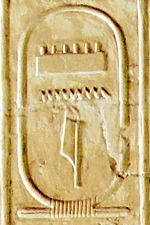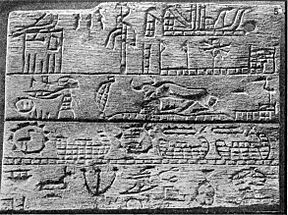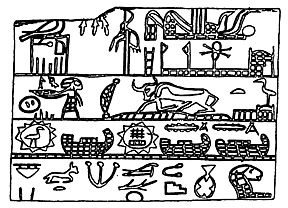Menes facts for kids
Quick facts for kids Menes |
|
|---|---|
| Africanus: Mênês Eusebius: Mênês Narmer (?) Hor-Aha (?) |
|

The cartouche of Menes on the Abydos King List
|
|
| Pharaoh | |
| Reign | c. 3200–3000 BC (First Dynasty) |
| Predecessor | if Narmer: Scorpion II? if Hor-Aha: Narmer |
| Successor | if Narmer: Hor-Aha if Hor-Aha: Djer |
| Burial | Umm El Qa'ab chambers B17 and B18 (Narmer’s burial) Umm El Qa'ab chambers B10/B15/B19 (Hor-Aha’s burial) |
Menes was a legendary pharaoh who lived around 3100 BC. He is famous in ancient Egyptian stories for uniting the two lands of Upper and Lower Egypt into a single kingdom. This act made him the founder of the very First Dynasty of pharaohs.
However, the true identity of Menes is a big puzzle for historians. Many experts believe that Menes might be the same person as another famous pharaoh, Narmer, or possibly his successor, Hor-Aha. This makes Menes one of the most mysterious figures in ancient history.
Contents
Who Was Menes?
Ancient stories describe Menes as a great founding hero, much like Romulus who founded ancient Rome. According to the Egyptian historian Manetho, Menes was a powerful warrior who created the first united Egyptian kingdom.
Later lists of kings, written by the Egyptians themselves, always show Menes as the very first human pharaoh to rule the land. They believed he inherited the throne directly from the god Horus.
Building a New Capital
The Greek historian Herodotus tells a story that Menes founded the great city of Memphis to be his capital. To do this, he supposedly built a huge dam to change the course of the Nile river, creating dry land for the new city.
However, other ancient writers said his son built the city. Today, archaeologists think this story might be a legend. A stone carving discovered in the Sinai Peninsula suggests Memphis already existed even before the time of Menes.
The Great Detective Story: Finding Menes
While the name "Menes" appears in many ancient lists of kings, archaeologists have found very few objects from his time with his name on them. This has led to a big debate among historians.
A Puzzle for Historians
The main question is: Was Menes a real person, or is "Menes" just another name for Narmer or Hor-Aha? The name Menes means "He who endures." It is possible this was not a personal name, but a special title given to the king who united the country. Historians act like detectives, using ancient objects as clues to solve this mystery from the past.
Clues from the Past
Because there are no history books from that long ago, experts must study ancient artifacts for answers. Here are some of the most important clues:
- The Naqada Label: An ivory tag found in a royal tomb shows the name of King Hor-Aha. Next to it is a building with a symbol inside that might spell "Menes." Some experts think this proves Hor-Aha was Menes. Others believe the symbol is just a word meaning "to endure" and not a name.
- The Abydos Seal: A clay seal impression found at Abydos shows Narmer's royal name next to the chessboard symbol "mn," which stands for Menes. This could mean Narmer's other name was Menes. But it could also be the name of a prince named Menes, who might have been Narmer's son.
Because the clues can be read in different ways, the debate continues. However, many Egyptologists believe that the evidence for Narmer being the unifier of Egypt is very strong, which makes him the most likely person to be the legendary Menes.
Legends of the First Pharaoh
Many amazing stories were told about Menes. He was seen as a king who changed Egypt forever.
A King of Many Firsts
Ancient writers said Menes brought many new ideas to Egypt. He was said to have introduced the proper way to worship the gods and practice sacrifice. Some also claimed he introduced a more luxurious and comfortable way of living. One later pharaoh, Tefnakht, even put up a stone pillar at Thebes complaining that Menes had made life too fancy!
The Crocodile Episode
A famous legend tells of a time Menes was out hunting when he was attacked by his own dogs. To escape, he jumped into Lake Moeris. A giant crocodile appeared and carried him to safety on its back. To thank the crocodile, Menes founded a city on that spot and named it Crocodilopolis. In this city, people worshipped the crocodile god Sobek.
A Dramatic End
According to the historian Manetho, Menes ruled for over 60 years. His life came to a surprising end when, as the story goes, he was killed by a hippopotamus.
When Did Menes Live?
It is very difficult to know the exact dates from so long ago. In the 19th century, historians suggested many different dates for when Menes lived. Today, most experts agree that the era of Menes, and the start of the First Dynasty, was sometime between 3200 BC and 3000 BC.
Images for kids
-
Two Horus names of Hor-Aha (left and center) and a name of Menes (right) in hieroglyphs.
See also








